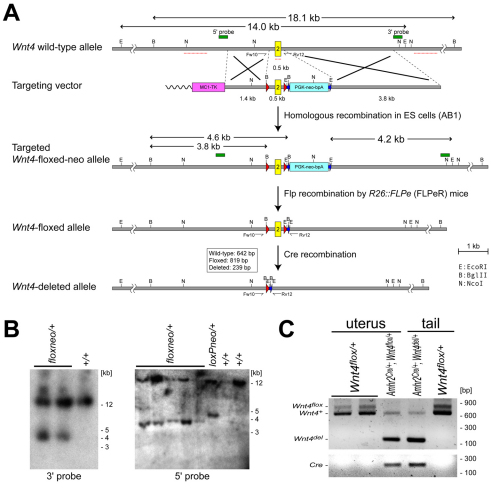Fig. 4.
Generation of a conditional null allele for Wnt4. (A) Schematic illustration of targeting strategy for a Wnt4 conditional null (floxed) allele. The genomic loci around exon 2 (yellow box) of the Wnt4 gene in different alleles are shown. Red triangles and green arrows indicate loxP and FRT sites, respectively. Red dashed lines indicate conserved regions between mouse and human. Fw10 and Rv12 indicate forward and reverse primers for PCR genotyping, respectively. (B) Confirmation of the targeted Wnt4 floxed allele by Southern hybridization. In total, five correctly targeted ES cell clones were obtained. Wnt4flox/flox mice were phenotypically normal. Wnt4 deleted (Wnt4flox) allele was generated from the Wnt4flox allele using ubiquitous Cre recombination in the embryonic tissue using the Mox2-Cre (More) allele (Tallquist and Soriano, 2000). After intercrossing, the resulting Wnt4del/del mice had identical phenotypes to those in Wnt4-null (Wnt4−/−) mice (Stark et al., 1994; Vainio et al., 1999) in the kidney, gonad and reproductive tract at birth, confirming that the Wnt4 floxed allele generates a null allele after Cre recombination (data not shown). (C) Recombination of the Wnt4 floxed allele by the Amhr2-Cre allele in the female reproductive tract. PCR genotyping with genomic DNA from the uterus of Wnt4flox/+ and Amhr2Cre/+; Wnt4flox/+ females at E18.5. Genomic DNA from the tail of Amhr2Cre/+;Wnt4del/+ and Wnt4flox/+ mice were used as controls.

